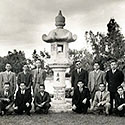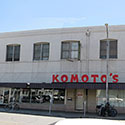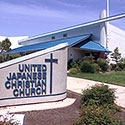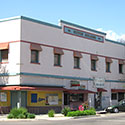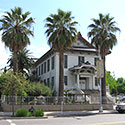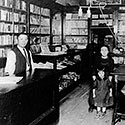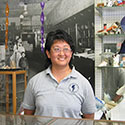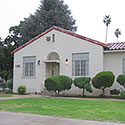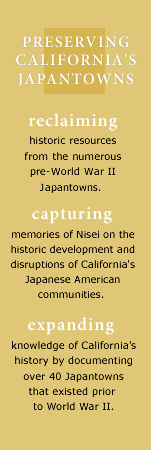 |
FresnoFresno's Nihonmachi with its large concentration of Japanese businesses and associations became the center of social, economic, religious, and political activity for Japanese in the Central Valley by the early 1900's. After the first Japanese to the valley arrived in the 1890's to farm at a Muscat grape vineyard, ranchers began recruiting Japanese workers from Sacramento and Stockton; and by 1897, nearly 3,000 Japanese grape pickers were working on ranches in the valley. Because of the region's scale and distance between the large ranches, Japanese businesses were set up in small towns for the growing number of migrant laborers. Fresno's Nihonmachi was established adjacent to Chinatown, on Kern and G Streets, and along Chinatown Alley. Japanese would frequent Fresno's Nihonmachi from the surrounding towns of Selma, Fowler, Reedley, Clovis, Parlier, Sanger, Kingsburg, and Madera, and from Kings and Tulare counties. By 1910, the Japanese population in Fresno County grew to 2,233, with 122 businesses and 9 organizations; and doubled in size by 1920 to 5,732 residents with 187 businesses. ››Go here to view the map of Fresno's Japantown in 1940. ›› CLICK TO ENLARGE.
PROFILES
| ||||

As a symbol of goodwill and friendship, a Japanese stone lantern was given to the City of Fresno by the Japanese business association in August, 1939. Community business leaders from the Japanese Young Men's Association (Japanese Y.M.A.) stood proudly with the stone lantern in front of the lake at Roeding Park for its original dedication, as shown in the photo. Ironically, after World War II when the community inquired about the whereabouts of the stone lantern, the city staff claimed that it had been discarded during the war. Nearly 60 years later, the lantern was recovered from the backyard of an estate and has since been re-dedicated in the Shinzen Japanese Friendship Garden at Woodard Park in Fresno.

Perched grandly on the corner of Kern and G Street, the Fresno Betsuin, a three-story rectangular structure with Japanese influence on its hip gable roof and carved wood ornament details, was rebuilt to its identical stature in 1920, after the original 1902 wooden structure was lost to a fire. Upon entering the wooden Torii gate, a Japanese garden greets the visitor and a wide staircase leads to the entry on the second level where the main office, meeting rooms, small altar, and minister's office are located; and an interior staircase leads to the temple on the 3rd floor. In its early years prior to World War II, the temple grounds also included a boarding house, a baseball diamond, tennis court, basketball court; and the surrounding dirt lot would be transformed into staging for a sumo tournament or track meet. The boarding house provided lodging for the minister and arriving Buddhist scholars until they were assigned to a temple, and later served as a boarding house for children of Japanese laborers.
With building underway for a new temple complex in northeast Fresno, the fate of this stately historic structure remains unknown, however with its imprint on the legacy of Fresno's Japantown, many community members and heritage advocates hope to preserve it.

Kamikawa Brothers, a multifaceted immigrant business enterprise was bold in its scope and investment, yet relied on the family support like many other Issei ventures. After operating Hinode Hotel in Fresno, Riichi Kamikawa called upon his brothers, Mitsuji, Masuichi, and Koichi from Japan in 1901 to open Kamikawa Brothers, a general merchandise store, located on Kern Street, beween G Street and China Alley. They expanded their business by opening stores outlying towns of Selma, Del Rey, and Hanford. Kamikawa Brothers was one of several Fresno businesses that sent horse-drawn wagons to farms to sell supplies on a regular circuit. The Fresno enterprise grew by 1905 to include a tailor shop, a public bath, a bank, a grocery, a Western-style restaurant, a hotel, with a branch hotel and storage nearby. The brothers also owned land in Selma, Hanford, and Sanger.
The Kamikawa Brothers established the Japanese American Bank in San Francisco and a Fresno branch in 1902, but was forced to close due to the threatened economy in 1912. They also started Hokubei Export and Import, with a Japan branch in Hiroshima. Financial strain ensued due to the practice of extending credit for debts paid after harvest, which decreased operating capital and often resulted in unpaid accounts. By the 1920s, Riichi Kamikawa returned to Japan and the enterprises began closing with the general merchandise store as the last to close in 1936. In 1938, Mr. Kanichi Komoto purchased the building and opened the Komoto Department Store, operating on the street level and basement. Although the store was closed from 1942-45, the family maintained its payments while interned during the war. They re-opened Komoto's in 1945, leased the top floor to proprietors of the Asia Hotel, and remained in operation until 1993.

Early Japanese businesses were established in Fresno's Chinatown from the 1890s, until Japantown was expanded to F and G Streets. Mataichiro and Tasu Masuda, proprietors of Masuda Bookstore, (shown in the photo with daughter Dorothy), resumed the business from his brother in 1910. The shop sold books and other dry goods from the left storefront of the Bing Kong Association building; and meetings for the Tong Association were held on the second floor. The Masuda Bookstore moved to several locations in Japantown, until operating in its final location on F Street next to the Ryan Theater movie house from 1934 to 1940, with its business expanding to offer ice cream and snow cones for the moviegoers.
A few doors down and across the way, the last remaining Japantown business on China Alley, the H.G. Ego Building, with family proprietors since 1926, has recently been donated to Fresno's Chinatown Revitalization Project. The very long narrow building, distinctive of structures built in Chinatown in the late 19th century, was used for a restaurant in the 1930s, was vacant from 1941-1960, then later served as Ego Dry Goods Store. Recent research on the site has unearthed ceramic dishes carefully wrapped in 1942 newspapers that were buried in the yard just prior to evacuation.

In response to the growing number of Japanese laborers in Fresno and Hanford, Rev. Zenjiro Hirota was appointed to the Japanese Mission of the Methodist Episcopal Church in 1893. By 1906, a church was constructed at 1260 Kern Street. The Methodist Church had its own tennis court and softball field that mirrored that of its neighbor, the Buddhist Church. When a proposed freeway project threatened the church in the mid-1950s, the congregation sold their property and purchased the St. George's Greek Orthodox Church at Fresno and Collins Street.
In 1906, the Congregational Oriental Mission Church sent a seminary student to meet with Japanese farm and railroad workers at the Chinese Mission Church. Less than a year after the new church for the Japanese Congregational Church was built, it was lost to a fire. However the community quickly rallied together to rebuild on adjacent land on F Street. Having outgrown their first site by the 1920s, the JCC purchased a 2-story church on E and Inyo Street. During the war, the conference urged JCC to sell its heavily vandalized buildings, the Japanese School on F Street and parsonage on B Street. After the war, due to the poor condition of the church on E Street, they sold the property and moved an army chapel from the fairgrounds to 806 Collins Ave in West Fresno, until a new building was dedicated in 1957. After 85 years for the Japanese Congregational Church and 100 years for Christ United Methodist Church, the two churches joined to form the United Japanese Christian Church in the 1990s. In moving north to Clovis, close to where the young families reside, UJCC thrives with worship service and multigenerational activity for children, youth, and its aging Nisei members.

In 1915, Kogetsu-Do was established by Sugimatsu Ikeda on Kern Street, selling manju, mochi and candy, before moving to its present location on F Street in 1920. Sugimatsu and his wife Sakino Ikeda operated the business and raised three children until the family was forcibly removed and detained at the Fresno Assembly Center, then interned in Jerome, Arkansas and Gila River, Arizona for the duration of World War II. After returning to Fresno, sons Roy and Masao Ikeda and their wives continued the family business; and their daughter Margaret started her own business as a hairdresser. When Roy Ikeda passed away in the mid-1960s, Masao and Dorothy continued the business with their Issei parents assisting until their retirement.
When her father became ill in the 1990s, Lynn Ikeda-Yada stepped in to assist her mother Dorothy and learn the business. "None of the family knew I was going to take this over," says Ikeda-Yada, who studied criminology in college. "I didn't want to see this die. There's a lot of family history in it." [Fresno Bee, Dec. 27, 2006] Kogetsu-do, nearly 100-years old, is the last remaining manju-ya in the Central Valley, providing traditional mochi for Japanese New Year's and special manju for community celebrations. Lynn has introduced fresh strawberry manju, chocolate mochi, and other flavors to satisfy today's palate.

The pair of buildings owned by the Nippon Building Corporation became the center of the growing Nihonmachi at the corner of F and Kern Street. Nippon Building No. 2 included commercial and residential uses, but the heart of the building was the Japanese Theatre, or Nippon Hall, used for plays and performances with elaborate set design and costumes. In the 1940s, the storefronts on Kern Street included Ito Co (Tailor), Home Drug, Nippon Hall, Lily's Beauty Parlor; and storefronts on Kern Street: Takemoto Barber, Star Shoe Repair, Fresno Printing, Matsuda Book Shop, Nichibei Kogyo Kaisha Branch, Dr. Taira, and the entrance to the Opera Hotel that occupied the second floor. The storefronts and hotel exist today, however the theater at the rear of the building is gone.
The Tenshodo Drug and Art Goods filled the corner space of Nippon Building No. 1, providing something for all - medicines, sundries, art supplies, and a soda fountain. Other commercial businesses facing F Street in the 1940s included Kaishu Mainichi, Tenshodo Drug and Art Goods, Bocho Club; and from Kern Street: Henmi Co Grocery, Yuki Restaurant, Arie Barber, Ogon Bath, Nishida Pool Hall. In the 1960-70s, Central Fish Co. and the Fuji Café began their businesses in Nippon Building #1 and are still in operation. Serving as the anchor for the few remaining Nikkei businesses, Central Fish moved to the corner of G & Kern Street and is now operated by Ernie Doizaki, the nephew of long-time proprietor Akira Yokomi and owner of American Fish in Los Angeles. Named in his honor, Yokomi Science & Technology Magnet School opened in 2005.

Just a few blocks from Japantown, Dr. George Kanomatsu Hashiba moved his offices in 1937 to this Spanish Colonial structure with distinctive molding above the entry on 544 Fresno Street in West Fresno. Prior to this location, he operated the Hashiba Sanitarium from 1926 to 1937 at the former site of the Nihon Byoin (Japanese Hospital) at 935 E Street. Built in response to a schism in the Japanese community, the Nihon Byoin was formed as a collective enterprise, similar to those established in Stockton and San Jose, resulted from a conflict in 1911 as to the celebration of the Meiji emperor's birthday. The then-Pastor of the Fresno Japanese Methodist Episcoal Church asserted that Christians should not worship the Emperor as a deity. Challenging the loyalty and respect for the emperor deeply divided the community and caused many Buddhists to refuse medical service at the Okonogi Hospital, due to Dr. Bunkuro Okonogi's strong Christian affiliation and role during the conflict.
Okonogi Hospital built in 1923, was a full service hospital with 38 rooms on the street level, and kitchen and dining area in the basement, located on the same block as the former Danish Creamery at 708 E Street, at the corner of Mono Street (now part of the expanded creamery). Dr. Bunkaro Okonogi was the first physician to serve the Fresno community and began his practice on F Street in the 1890s. He also served as the president of the Japanese Association of Fresno and Industrial Bank of Fresno. During evacuation, he moved operations to the Pinedale Assembly Center, then served as a physician at Poston, Arizona. Upon his release from camp, he was joined by his son, Dr. Hugo Okonogi, and resumed hospital operations until his death in 1950 at the age of 78.
